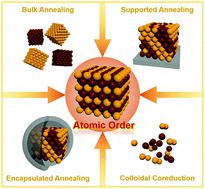Our official English website, www.x-mol.net, welcomes your
feedback! (Note: you will need to create a separate account there.)
The impact of synthetic method on the catalytic application of intermetallic nanoparticles.
Nanoscale ( IF 5.8 ) Pub Date : 2020-08-24 , DOI: 10.1039/d0nr04699j Benjamin P Williams 1 , Zhiyuan Qi , Wenyu Huang , Chia-Kuang Tsung
Nanoscale ( IF 5.8 ) Pub Date : 2020-08-24 , DOI: 10.1039/d0nr04699j Benjamin P Williams 1 , Zhiyuan Qi , Wenyu Huang , Chia-Kuang Tsung
Affiliation

|
Intermetallic alloy nanocrystals have emerged as a promising next generation of nanocatalyst, largely due to their promise of surface tunability. Atomic control of the geometric and electronic structure of the nanoparticle surface offers a precise command of the catalytic surface, with the potential for creating homogeneous active sites that extend over the entire nanoparticle. Realizing this promise, however, has been limited by synthetic difficulties, imparted by differences in parent metal crystal structure, reduction potential, and atomic size. Further, little attention has been paid to the impact of synthetic method on catalytic application. In this review, we seek to connect the two, organizing the current synthesis methods and catalytic scope of intermetallic nanoparticles and suggesting areas where more work is needed. Such analysis should help to guide future intermetallic nanoparticle development, with the ultimate goal of generating precisely controlled nanocatalysts tailored to catalysis.
中文翻译:

合成方法对金属间纳米粒子催化应用的影响。
金属间合金纳米晶体已经成为有前途的下一代纳米催化剂,这主要是由于它们具有表面可调性的前景。纳米颗粒表面的几何和电子结构的原子控制提供了对催化表面的精确控制,并具有创建遍布整个纳米颗粒的均匀活性位的潜力。然而,由于母体金属晶体结构,还原电势和原子尺寸的差异,合成困难限制了实现这一希望。此外,很少关注合成方法对催化应用的影响。在这篇综述中,我们试图将两者联系起来,组织当前金属间纳米粒子的合成方法和催化范围,并提出需要更多工作的领域。
更新日期:2020-09-24
中文翻译:

合成方法对金属间纳米粒子催化应用的影响。
金属间合金纳米晶体已经成为有前途的下一代纳米催化剂,这主要是由于它们具有表面可调性的前景。纳米颗粒表面的几何和电子结构的原子控制提供了对催化表面的精确控制,并具有创建遍布整个纳米颗粒的均匀活性位的潜力。然而,由于母体金属晶体结构,还原电势和原子尺寸的差异,合成困难限制了实现这一希望。此外,很少关注合成方法对催化应用的影响。在这篇综述中,我们试图将两者联系起来,组织当前金属间纳米粒子的合成方法和催化范围,并提出需要更多工作的领域。











































 京公网安备 11010802027423号
京公网安备 11010802027423号